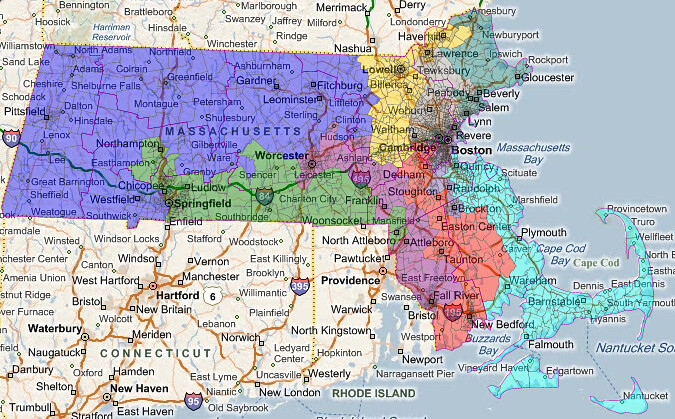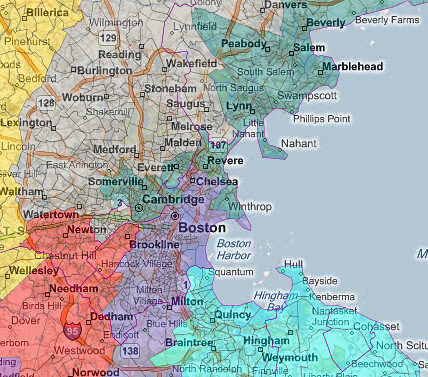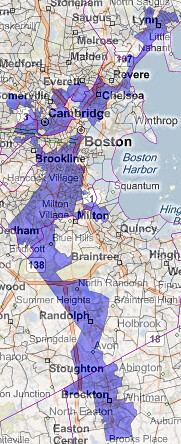Today’s Census data dump is three slow-growth northern states: Massachusetts, Michigan, and New Hampshire. Massachusetts is set to lose one seat (from 10 down to 9), meaning its new target is 727,514 (up from about 634K in 2000). Interestingly, the growth among all the districts was pretty consistent, with only about 20,000 difference between the state’s largest and smallest districts. Estimates over the decade had shown Boston losing population, but in the final count it did eke out a small gain.
With no clear loser on the population front among the districts, that makes the question of who draws the shortest redistricting straw even more complicated… unless someone reverses course and decides to retire, either to challenge Scott Brown (most likely Mike Capuano or Stephen Lynch) or to call it a career (John Olver). Olver’s 1st did wind up being the smallest by a small margin, so the most talked-about mashup of the 1st and 2nd may well happen; alternatively, based on seniority the axe could fall on the delegation’s newest member, William Keating. At any rate, with Dems firmly in charge of the process, don’t look for any of these districts to lose their bluish hues; the main question is who gets left without his musical chair.
| District | Rep. | Population | Deviation |
|---|---|---|---|
| MA-01 | Olver (D) | 644,956 | (82,558) |
| MA-02 | Neal (D) | 661,045 | (66,469) |
| MA-03 | McGovern (D) | 664,919 | (62,595) |
| MA-04 | Frank (D) | 656,083 | (71,431) |
| MA-05 | Tsongas (D) | 662,269 | (65,245) |
| MA-06 | Tierney (D) | 650,161 | (77,353) |
| MA-07 | Markey (D) | 648,162 | (79,352) |
| MA-08 | Capuano (D) | 660,414 | (67,100) |
| MA-09 | Lynch (D) | 650,381 | (77,133) |
| MA-10 | Keating (D) | 649,239 | (78,275) |
| Total: | 6,547,629 |
When it was revealed in December that Michigan was the only state out of 50 that actually lost population since 2000, it was clear that the state’s urban districts were in a world of hurt… but I have to admit I’m still surprised at the way that Detroit has utterly cratered. The Motor City, at one point the 4th largest city in America, is now down to 15th, with a population of 713,777 (now smaller than johnny-come-latelies like Columbus, Austin, and Charlotte). The 13th may be the 2nd least populous district in the country at this point (after WY-AL). I briefly had to wonder whether we might actually see Detroit turned into one CD, mostly contiguous with the city boundaries (since it’s now about the same population as an ideal district), but I can’t imagine that the Obama administration’s DOJ would allow the state GOP (which controls the redistricting trifecta) to pack only one overwhelmingly African-American VRA district when the population is there to support two, albeit two that will have to reach significantly into the suburbs now.
Michigan’s current target is 705,974 (based on the drop to 14 from 15 seats), up from about 663K in 2000. That means that six of its districts (the Upper Peninsula-based 1st, the Flint-and-Saginaw 5th, and the 9th and 12th in Detroit’s northern suburbs, in addition to the 13th and 14th) outright lost population over the decade. With the 9th and 12th also big losers, and with the VRA looming over the 13th and 14th, this all seems to confirm what most people are expecting, that Gary Peters and Sandy Levin are going to get much better acquainted with each other in a Dem primary. If you go further out into the districts that contain Detroit’s exurbs (the GOP-held 8th and 10th), those are the two districts in the state that actually need to shed some population.
| District | Rep. | Population | Deviation |
|---|---|---|---|
| MI-01 | Benishek (R) | 650,222 | (55,752) |
| MI-02 | Huizenga (R) | 698,831 | (7,143) |
| MI-03 | Amash (R) | 694,695 | (11,279) |
| MI-04 | Camp (R) | 686,378 | (19,596) |
| MI-05 | Kildee (D) | 635,129 | (70,845) |
| MI-06 | Upton (R) | 671,883 | (34,091) |
| MI-07 | Walberg (R) | 676,899 | (29,075) |
| MI-08 | Rogers (R) | 707,572 | 1,598 |
| MI-09 | Peters (D) | 657,590 | (48,384) |
| MI-10 | Miller (R) | 719,712 | 13,738 |
| MI-11 | McCotter (R) | 695,888 | (10,086) |
| MI-12 | Levin (D) | 636,601 | (69,373) |
| MI-13 | Clarke (D) | 519,570 | (186,404) |
| MI-14 | Conyers (D) | 550,465 | (155,509) |
| MI-15 | Dingell (D) | 682,205 | (23,769) |
| Total: | 9,883,640 |
These two district states are really drama-free, and New Hampshire might be the least dramatic of all. The two districts in the state stayed remarkably balanced (as they always do… the state has had two districts since the 1800s, with the boundaries rarely moving much), to the extent that the 1st needs to pick up only 254 people from the 2nd. I’ll leave it to the good folks in comments to argue over which ward in Hooksett should be the one that gets moved. (New Hampshire’s target was 658,235, up from 618K in 2000.)
| District | Rep. | Population | Deviation |
|---|---|---|---|
| NH-01 | Guinta (R) | 657,984 | (254) |
| NH-02 | Bass (R) | 658,486 | 254 |
| Total: | 1,316,470 |




























